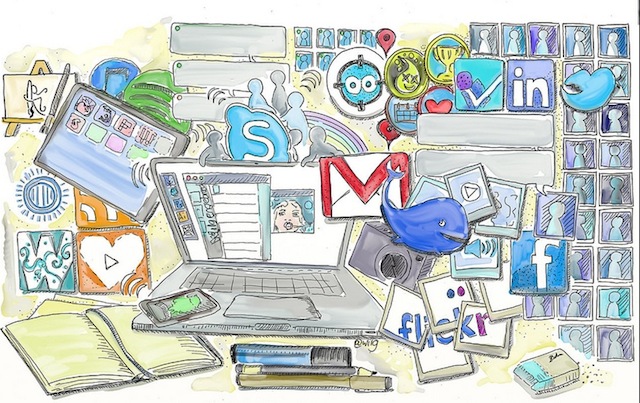
Binging on Facebook. Scrolling through Instagram as I sit in front of the TV with my family after an exhausting week. Checking email on my phone while sitting through a tele-conference on another device. Grabbing my phone in the middle of a conversation to begin researching what we are talking about as we then talk about something else I will eventually look up. Driving in a car full of people with the radio on and every single person except the driver is on their device of choice.
These are all moments most of us experience.
The problem is that these moments aren’t really moments anymore, instead, they are a constant part of life.
I’ve been struggling with finding a balance with technology for years. There are times I follow a super strict technology diet—like someone that gives up all sugar—vigilantly monitoring my usage of certain apps but letting other things like email or texting continue to run amok.
Other times, I go on an internet and electronic fast and abstain from all usage except answering my phone and text messages. (Phone calls and texts are especially difficult to give up when you are still trying to monitor the needs of your family.)
When I came across an article in Psychology Today by Nancy Colier that discusses the relationship we have with our electronics, I began to wonder: What I could do to promote good habits with a more moderate technology diet in my life?
According to Colier, the average person checks their smartphone 190 times a day. While I’m not sure of the exact number of times I check my phone, I have to admit that I pride myself on being the person in my family that the kids contact because I always respond quickly.
The thing is, I know that with more electronic usage I become grumpy, miserable and anxious. I’ve known this for years.
If you want to put me in a bad mood, make me watch TV for three hours straight. When I was a young adult, I would take breaks from people I was in serious relationships with so that they could have TV days and I could have time alone to read. I may not be the average person but still I find myself caught up in this socially acceptable technology addiction.
In her article, Colier states:
“The only difference between technology addiction and other addictions is that we have all drunk the Kool-Aid; we’re all in on this one. It used to be that an addiction caused us to be excluded from society, but technology addiction makes us an insider, part of the club.”
The problem with this technology “Kool-Aid” is that everyone is at the party and everyone is drinking up. We are like a bunch of diabetics craving sugar; we’re indulging in massive amounts without understanding the long term implications.
Numerous studies have shown technology use increases anxiety and decreases attention span. The retention of information consumed via electronic format is shown to be significantly less than physical copy. Like a sugar addict craving simple over-processed sugary carbs, we crave technology.
The thing is, I don’t believe we can just abstain from technology completely or indulge without remorse.
Modern-day life is going to have technology in it. How do we move away from the excess intake and toward a moderate diet of technology?
While I definitely don’t have all of the answers, here are four simple rules I am implementing into my daily life to develop a more moderate diet of electronics.
- Create boundaries around the time and technology. While I’ve done this one before, I found it ineffective if I was too lenient and a struggle if I was too strict with myself. Starting small and then increasing my time away from technology helped. During the work week, I allow myself to check my email once an hour to respond to emails in a timely manner. For someone else, they may be able to check their email even less.
.
Boundaries around technology usage work best when we take the time to look at our lives and truly recognize what is required for our lifestyle and what can be let go of. A good way to do this is to think of what life was like 10 years ago and how people interacted with technology and compare it to now.
. - Return of the ringer. For me, turning my phone’s ringer on instead of to vibrate and placing my phone out of reach was a more moderate way of interacting with electronics. It doesn’t really matter if my kids can reach me instantly or if I have to return their call because I am in the other room when the phone rings. When I began to understand this, I began to let go of the need to be instantly reached.
. - Have dessert, just not that often. As much as I would love to eat cake at every meal, it simply isn’t good for me and neither is too much time spent on online games or looking at other people’s posts on Facebook or some other social media site. By choosing how I splurge on these things and setting a timer to remind me, I have an easier time saying no to over indulging. Too often, I’ve given myself the excuse to wander around and do a quick look at posts from friends only to find I’ve wasted hours.
. - Support local used bookstores. I love all of the possibilities that come with having an app to read on my computer, phone, tablet and every other device I can get your hands on. While this seemed convenient at first, it was too easy to go from the book I was reading to things like Instagram or Twitter.
.
I hate to admit it, but when I read on my phone, I regularly take Facebook and Instagram breaks and also randomly search topics online as they pop into my head. When I recognized this and went back to reading hard copies, I truly read what was in front of me and stopped jumping from place to place on a device. With limited space in my home for more bookcases, I give those used books away to friends or donate them to my local charity. Another option I’ve been contemplating is to start a neighborhood outdoor Little Free Library. You can start your own Little Free Library.
Like a diet of food, our technology diet needs to be filled with things that nurture us and leave us feeling healthy and inspired. If you have more ideas on how to implement a moderate technology diet, please post them in the comments below.
“Technology, for instance, has become a kind of imposter for connection, making us believe we’re connected when we’re really not—at least not in the ways we need to be. In our technology-crazed world, we’ve confused being communicative with feeling connected.” ~ Brené Brown
~
Author: Nicole Marchant
Image: Albertojuanse/Wikimedia Commons
Editor: Caitlin Oriel











Read 0 comments and reply